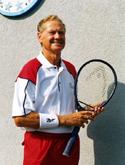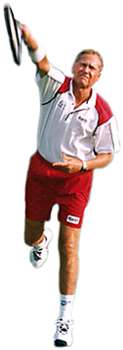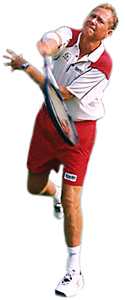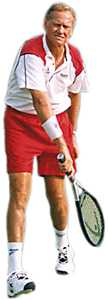

The Y2K Serve
by
Dennis Van der Meer
President of the U.S.P.T.R. and
Van der Meer TennisUniversity
 Though all serves
have the same basic fundamentals, modern high speed rackets and better
player physiology are encouraging men and women professional tennis
players to develop distinctly individual serving styles. The result is
that many more players than ever before can now serve at over 120mph. Though all serves
have the same basic fundamentals, modern high speed rackets and better
player physiology are encouraging men and women professional tennis
players to develop distinctly individual serving styles. The result is
that many more players than ever before can now serve at over 120mph.
If your technique is fundamentally sound, you also have the potential
to reach this magic number. Despite individual differences, all
professionals use the same basic technique.
The serve resembles an upward throwing motion of the racket towards the
ball. There is a kinetic chain as the feet, facilitated by the knees
bending, push against the ground; and the hips and shoulders rotate away
from the net. This is the loading phase.
Then in preparation of the hit, the body turns towards the net; the
elbow turns forward and keeps the racket on edge just before the moment of
impact; then the upper arm rotates inward turning the elbow outward and,
as the wrist rolls through at ball impact, the racket has maximum
explosive speed.
Now comes the dilemma. Among all the proliferating serving styles,
whose technique should you try to copy? My recommendation is that you
first develop the biomechanically sound standard method serve, and,
afterwards, experiment with personal preferences to evaluate which gives
you the best results.
The Standard Grip
Use a grip mid-way between the eastern forehand grip and the eastern
backhand grip. To find the grip, hold your racket like a hammer.
Variations
- Using the hammer grip as a base, some players go over more towards
the eastern backhand grip, particularly for imparting more spin.
The extreme would be almost a full backhand grip such as used by
former world champion Stefan Edberg.
- Some players go a bit more towards the eastern forehand grip for a
flat serve, and there are examples of players such as former champion
Boris Becker who served
 with almost a full eastern forehand grip.
with almost a full eastern forehand grip.
Just be aware that when you use an extreme grip, you will have to make
some other adaptations to your serve to accommodate these extreme grips.
The Standard Stance - The Feet
Watch world class players when they are just taking a few casual warm
up serves - before they go into their individual ritualistic stances. You
will notice they stand with their feet about shoulders’ width apart. The
right foot is parallel to the baseline, and the left foot is turned in
about 45 %. The weight is on the back foot, but the left foot is still
flat on the ground. This is the standard stance used by most players. To
practice this stance, just imagine you are waiting for a bus.
Variations
- Several years ago former world champion John McEnroe adopted a weird
stance by changing from his normal orthodox stance to a completely
sideways position to the net. Despite his explanation that he was
doing this because of a strained back,
 many juniors all over the world imitated this stance, much to the
chagrin of tennis teachers. Despite this weird look, it became
probably the best left handed serve in the world.
many juniors all over the world imitated this stance, much to the
chagrin of tennis teachers. Despite this weird look, it became
probably the best left handed serve in the world.
- Another example of a much-copied stance is that of Pete Sampras. He
starts with the heel of his left foot on the ground and his toe up. It
works for him but may not be for everyone because it takes very good
body balance to imitate.
- Other variations from the standard stance are standing with the feet
too close together, too wide apart, feet facing the net, pigeon-toed
and duck toed stances.
The Standard Stance - The Racket and Body
The weight is on the back leg and the body is straight. The head is
erect. The racket is held waist high and supported with the left hand so
that the head of the racket is about 110 degrees to the sky. The edge of
the racket is pointing to the net.
Variations
- Some players lean way forward and stick out their derriere. Some
look down, some look towards the sky.
- Some start with the racket position drooped below the knee, and
others raise the racket to head high. There is also a plethora
of body jiggles and facial contortions. Boris Becker used
to stick out his tongue, and Ivan Lendel would pluck his eye brows.
The Standard Ball Toss and Back Swing
The ball tossing arm and racket arm start together at waist height;
both arms go down together. When the tossing arm reaches the left thigh,
the arms separate. The tossing arm reverses direction and, with the arm
extended forward, reaches up to release the ball. The racket arm continues
in a very relaxed downward swing and then lifts up to head height.
The palm is down and the racket is in a cocked position. The ball is
tossed just a few inches above the intended racket impact point. The right
shoulder is tilted down and is just inside the line of the left arm. The
right hip is inside the line of the left arm. 
Variations
This is the area where there are many individual choices outside the
standard commonality.
- Some players toss the ball up with the left arm parallel to the
right side line.
- Some players hook the toss as the tossing arm swings in a circular
motion.
- Some toss the ball exactly to the intended contact point; some toss
the ball to make racket contact while the ball is still rising, and
there are players such as former world champion Steffi Graf who tossed
the ball more than five feet above the intended contact point.
- Some players first toss the ball and then let the racket catch up;
others do exactly the opposite by starting with the swing and have the
ball toss catch up.
- Some players just lift the racket from the front ala Patrick Rafter,
and this technique is becoming quite popular.

- At the opposite extreme are those players who have a huge hip and
shoulder rotation and have an extreme back swing where the racket
points clear towards the left of the baseline.
- Some players drop the elbow almost to rest on the right hip.
- Some raise the elbow so high the tossing arm and racket look like a
bird spreading its wings.
The Standard Use of the Feet Knees and Legs
In the loading phase of the serve, through the ground up kinetic chain,
turn the knees a little inwards and have the knees moderately bent to help
the feet push off against the ground at the completion of the toss. The
feet remain apart in the standard stance. This is referred to as a
platform position.
Variations
- Some players bring the feet together in a pin point stance.
- Some players make a massive knee bend where the knees almost touch
the ground.
- Some players bend the knees while the tossing arm is still rising.
- Some twist the knees excessively inward to face to the right of the
baseline.
The Standard Hit and Follow-through
From the cocked position, the racket loops around behind the back. The
hips and shoulders start to turn forward and the elbow leads the racket head. As
the edge of the racket is lined up with the ball, the upper arm turns
inward and the elbow extends upwards while rolling outwards. The final
link is the roll of the wrist through the ball impact. The left arm tucks
in close to the chest. The racket finishes with a smooth de-acceleration.
All the weight is transferred forward. The right leg just pivots forward
on the right toe.
shoulders start to turn forward and the elbow leads the racket head. As
the edge of the racket is lined up with the ball, the upper arm turns
inward and the elbow extends upwards while rolling outwards. The final
link is the roll of the wrist through the ball impact. The left arm tucks
in close to the chest. The racket finishes with a smooth de-acceleration.
All the weight is transferred forward. The right leg just pivots forward
on the right toe.
Variations
- Some players snap their wrist rather than pronate; some bend
the elbow; some follow through to an abrupt stop; some players keep
the body sideways throughout the hit.
- Some players fling the left arm to the side of the body.
- Some players turn the knees in sharply just before the forward turn
of the body towards the net
- Some players take a step with the right foot in front of the left
foot to increase the body torque.
- After contact many players step through with the right leg.
Some players do a scissors kick; some players jump onto the left foot
and kick the right leg backwards; some kick the right leg towards the
right of the base line, and there are many more less used individual
variations.
If the racket head comes through very fast, it is not uncommon for the
feet to leave the ground just before impact. This should be a natural
extension of the ground reaction forces. Some players, however,
deliberately jump off the ground to make the impact point higher. This has
the advantage of increasing the size of the window above the net by
several inches. It can be distinctly advantageous, providing the
complexity of the jump does not make the serve less reliable.
So there you have it. Master the basic standard serve and then develop
your own style by choosing from a wide menu of options.
Dennis Van der Meer, voted U.S. Olympic Development Coach
of the Year, has taught more people to play and teach tennis
than anyone in the history of the game. From legendary
world champions Billie Jean King and Margaret Court, who received
coaching from Dennis during their careers, he continues to help
develop the games of many ATP players, WTA players and up-and-coming
young players at the Van Der Meer World Class Tennis Academy
located on beautiful Hilton Head Island, South Carolina, USA.
Dennis Van der Meer and his staff can be reached in the USA
by phoning 1-800-845-6138 or faxing (843) 785-7032. From outside
the United States, dial 001-843-785-8388 and fax 001-843-785-7032.
Send E-Mail to tennis@vandermeertennis.com or
stop by the web site: www.vandermeertennis.com
|


 Though all serves
have the same basic fundamentals, modern high speed rackets and better
player physiology are encouraging men and women professional tennis
players to develop distinctly individual serving styles. The result is
that many more players than ever before can now serve at over 120mph.
Though all serves
have the same basic fundamentals, modern high speed rackets and better
player physiology are encouraging men and women professional tennis
players to develop distinctly individual serving styles. The result is
that many more players than ever before can now serve at over 120mph. with almost a full eastern forehand grip.
with almost a full eastern forehand grip. many juniors all over the world imitated this stance, much to the
chagrin of tennis teachers. Despite this weird look, it became
probably the best left handed serve in the world.
many juniors all over the world imitated this stance, much to the
chagrin of tennis teachers. Despite this weird look, it became
probably the best left handed serve in the world.


 shoulders start to turn forward and the elbow leads the racket head. As
the edge of the racket is lined up with the ball, the upper arm turns
inward and the elbow extends upwards while rolling outwards. The final
link is the roll of the wrist through the ball impact. The left arm tucks
in close to the chest. The racket finishes with a smooth de-acceleration.
All the weight is transferred forward. The right leg just pivots forward
on the right toe.
shoulders start to turn forward and the elbow leads the racket head. As
the edge of the racket is lined up with the ball, the upper arm turns
inward and the elbow extends upwards while rolling outwards. The final
link is the roll of the wrist through the ball impact. The left arm tucks
in close to the chest. The racket finishes with a smooth de-acceleration.
All the weight is transferred forward. The right leg just pivots forward
on the right toe.

